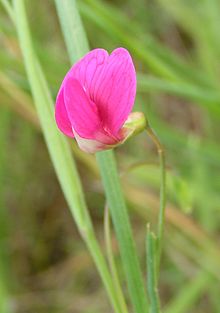|
Lathyrus
Lathyrus /ˈlæθɪrəs/[3] is a genus of flowering plants in the legume family Fabaceae, and contains approximately 160 species. Commonly known as peavines or vetchlings,[1] they are native to temperate areas, with a breakdown of 52 species in Europe, 30 species in North America, 78 in Asia, 24 in tropical East Africa, and 24 in temperate South America.[4] There are annual and perennial species which may be climbing or bushy. This genus has numerous sections, including Orobus, which was once a separate genus.[5] The genus has numerous synonyms, including Pisum, the ancient Latin name for the pea.[6] Species        181 species are currently accepted.[2][7]
EcologyLathyrus species are used as food plants by the larvae of some Lepidoptera species, including the grey chi (Antitype chi) and the latticed heath (Chiasmia clathrata), both recorded on meadow vetchling (Lathyrus pratensis), and Chionodes braunella. Lathyrus growth abundance and size both decrease in response to increased temperatures in montane meadows.[9] UsesSeveral species are grown for food, including the pea (Lathyrus oleraceus), Indian pea (L. sativus), and the red pea (L. cicera), and less commonly cyprus-vetch (L. ochrus) and Spanish vetchling (L. clymenum). The tuberous pea (L. tuberosus) is grown as a root vegetable for its starchy edible tuber. The seeds of some Lathyrus species contain the toxic amino acid oxalyldiaminopropionic acid and if eaten in large quantities can cause lathyrism, a serious disease.[10] Many species are cultivated as garden plants. The genus includes the garden sweet pea (Lathyrus odoratus) and the perennial everlasting pea (Lathyrus latifolius). Flowers on these cultivated species may be rose, red, maroon, pink, white, yellow, purple or blue, and some are bicolored. They are also grown for their fragrance. Cultivated species are susceptible to fungal infections including downy and powdery mildew. Notes
External links
|
||||||||||||||||||||||||||||||||||||||
